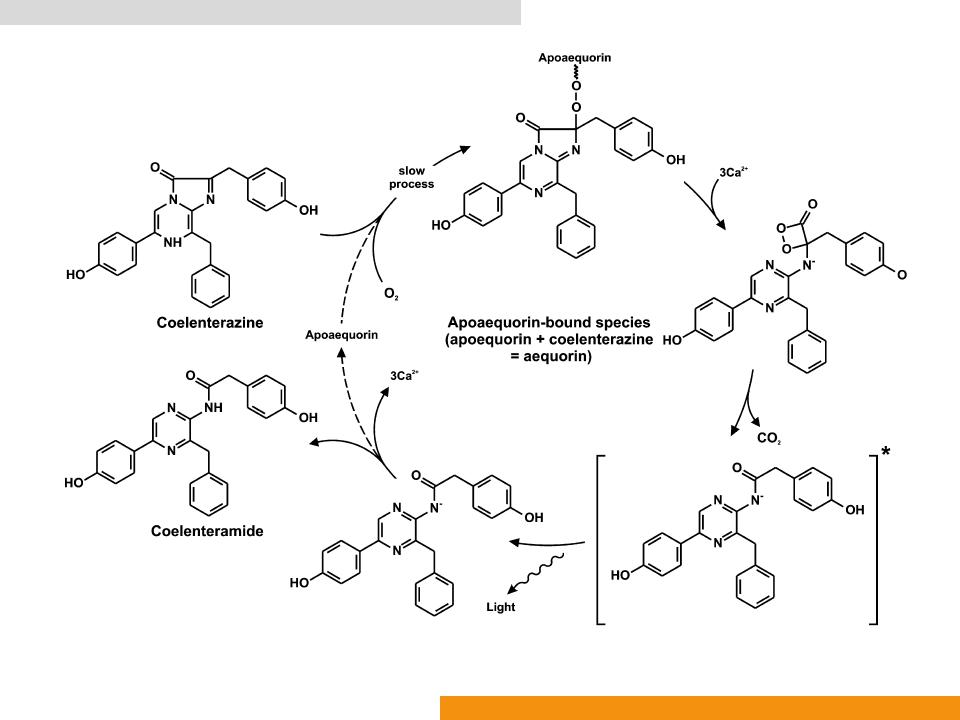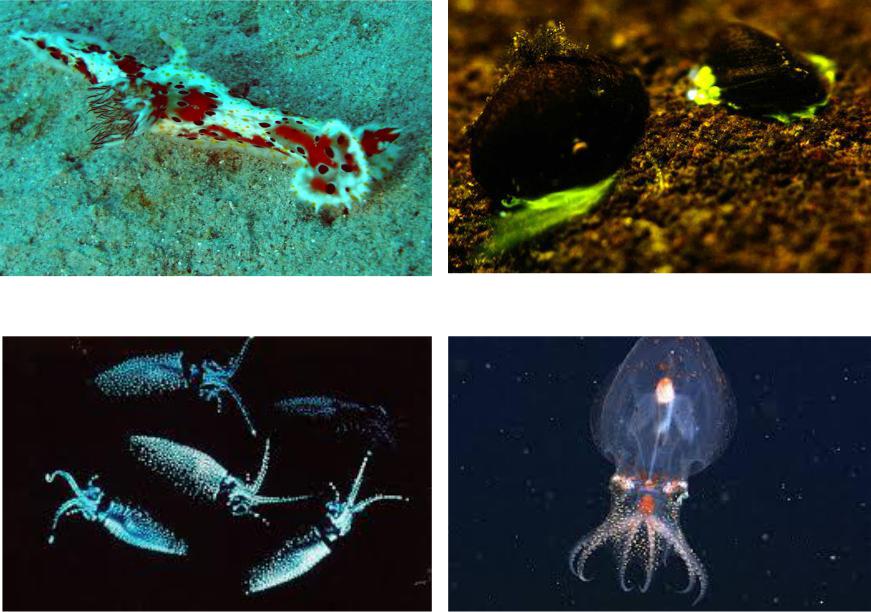
Physics and chemistry of bioluminescence - Rajeev Ranjan, PhD
.pdf
Aequorin system: Photoprotein (Aeq : EC 1.13.12.5)
•Catalyzes oxidation of luciferin (Coelenterazine)
•High-energy enzyme substrate complexes
•More stable than their dissociated components
•Can release the excess energy in a flash light emission triggered by Ca2+ ions
•Phylum: Cnidaria, Class: Hydrozoa, Family: Aequoreidae, Genus: Aequorea, Species: A. Aequorea (A. victoria)
•Reconstitution of the photoprotein is a relatively slow process occurring in the presence of coelenterazine and oxygen
•Aequorin is a holoprotein composed of two distinct units, the apoprotein that is called apoaequorin, which has an approximate molecular weight of 21 kDa, and the prosthetic group coelenterazine
•Displays an emission peak at 470 nm (blue light)


Obelin system: Photoprotein (Obe: EC 1.13.12.5)
•Luminescence of the Obelia species is due to the presence of Ca2+ sensitive photoproteins
•Phylum: Cnidaria, Class: Hydrozoa, Family: Campanulariidae, Genus: Obelia, Species: Obelia geniculata
•Photoproteins emit blue light (λmax 475 nm) when Ca2+ is added
•Differs from the green luminescence (λmax 508 nm) emitted from the live specimens
•The chemical mechanism of obelin luminescence is considered to be identical with that of aequorin
•However, there are some differences!!.........?

Other bioluminescence systems
•In Mollusca, bioluminescence occurs in a great variety of organisms
•Gastropoda (limpets, snails and sea hares)
•Bivalvia (clams)
•Cephalopoda (squids and octopuses)
•All luminous molluscs currently known are marine organisms except…..?
•Luminous gastropods include Latia neritoides and Planaxis labiosus
•Planaxis emits light from its body only upon stimulation; it does not produce any luminous secretion
•The snail is negative in the luciferin-luciferase reaction, and does not contain coelenterazine or Cypridina luciferin
•Class Cephalopoda contains a large numbers of luminous species
•Only three kinds of octopus have been confirmed to be bioluminescent: Japetella, Eledonella and Stauroteuthis syrtensis

Plocamopherus (Sea Slug) |
Latia neritoides |
Watasenia scintillans (Firefly squid) |
Japetella |

References
•Shimomura O (2006) Bioluminescence: Chemical Principles and Methods, World Scientific Publishing.
•Roda A, Guardigli M, Michelini E, Mirasoli M (2009) Bioluminescence in analytical chemistry and in vivo imaging. Trends Anal Chem 28:307–322.
•Thompson EM, Nagata S, Tsuji FI (1989) Cloning and expression of cDNA for the luciferase from the marine ostracod Vargula hilgendorfi. Proc Natl Acad Sci 86:6567–6571.
•Haddock SHD, Moline MA, Case JF (2010) Bioluminescence in the Sea. Annu Rev Mar Sci 2:293–343
•Schultz LW, Liu L, Cegielski M, Hastings JW (2005) Crystal structure of a pH-regulated luciferase catalyzing the bioluminescent oxidation of an open tetrapyrrole. Proc Natl Acad Sci 102:1378–1383
•Markova SV, Golz S, Frank LA, Kalthof B, Vysotski ES (2004) Cloning and expression of cDNA for a luciferase from the marine copepod Metridia longa. J Biol Chem 279:3212–3217
Thank you
